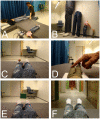Being Barbie: the size of one's own body determines the perceived size of the world
- PMID: 21633503
- PMCID: PMC3102093
- DOI: 10.1371/journal.pone.0020195
Being Barbie: the size of one's own body determines the perceived size of the world
Abstract
A classical question in philosophy and psychology is if the sense of one's body influences how one visually perceives the world. Several theoreticians have suggested that our own body serves as a fundamental reference in visual perception of sizes and distances, although compelling experimental evidence for this hypothesis is lacking. In contrast, modern textbooks typically explain the perception of object size and distance by the combination of information from different visual cues. Here, we describe full body illusions in which subjects experience the ownership of a doll's body (80 cm or 30 cm) and a giant's body (400 cm) and use these as tools to demonstrate that the size of one's sensed own body directly influences the perception of object size and distance. These effects were quantified in ten separate experiments with complementary verbal, questionnaire, manual, walking, and physiological measures. When participants experienced the tiny body as their own, they perceived objects to be larger and farther away, and when they experienced the large-body illusion, they perceived objects to be smaller and nearer. Importantly, despite identical retinal input, this "body size effect" was greater when the participants experienced a sense of ownership of the artificial bodies compared to a control condition in which ownership was disrupted. These findings are fundamentally important as they suggest a causal relationship between the representations of body space and external space. Thus, our own body size affects how we perceive the world.
Conflict of interest statement
Figures





References
-
- Poincaré H. New York: Dover. pp 93–116. Originally published as (1908) Science et Méthode. Paris: Flammarion; 1952. Science and Method.
-
- Merleau-Ponty M. London: Routledge; 1962. Phenomenology of Perception. p. 466 p.
-
- Goldstein E, Bruce V. Perceiving visual space. In: Goldstein E, Bruce V, editors. Sensation and Perception. Pacific Grove: Brooks/Cole Publishing Company; 1999. pp. 215–231.
-
- Cutting JE, Vishton PM. Perceiving layout and knowing distances: The integration, relative potency, and contextual use of different information about depth. In: Epstein W, Rogers S, editors. Perception of space and motion. San Diego: Academic Press; 1995. pp. 69–117.
-
- Gulick WL, Lawson RB. New York: Oxford University Press; 1976. Human stereopsis: A psychophysical approach.292
Publication types
MeSH terms
LinkOut - more resources
Full Text Sources
Other Literature Sources

